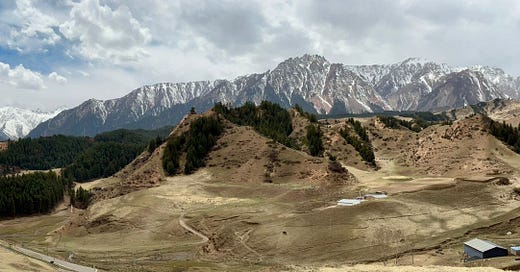The convoluted yet magnificent tale of King Gesar
The literary tradition of King Gesar is even more confused and complex than those of King Arthur or Roland
During my April visit to the Hexi Corridor, the geographic region where China interfaced with the regions to its west, I visited the Horse Hoof Temple complex, which consists of a large group of grottoes (Buddhist caves) numbering seven different sites of historical, archeological, and religious significance stretching 30 kilometers. The caves are accessed through a long drive in the picturesque shadow of the Qilianshan, or the Qilian Mountains. A long and pleasant drive to the entrance of Horse Hoof Temple under the blue skies of Sunan Yugu Autonomous County first leads to a striking gate demarcating the entry to the sacred ground. It’s quite a while before you actually reach any of the grottoes, but that was fine with me: the natural scenery is breathtaking even before you reach the sites.
The name “Horse Hoof” (mati) is most commonly associated with one of the “main” halls, which is fittingly called Horse Hoof Hall (mati dian 马蹄殿). This is an important grotto at the North Horse Hoof Temple area, and renowned for the large hoof print near a very tall Buddha image. Legend says that this hoof print belonged to a celestial horse ridden by King Gesar, the hero of one of the longest and most complicated folk poems in the world: the Epic of King Gesar.
Gesar is a shadowy character who is the warrior leader of the legendary kingdom of Ling, which seems to be a mystical mirror of the historical Tibet. He is the martial representative of none other than Avalokiteshvara, the bodhisattva of compassion. But he is no passionless monastic: he gets drunk, loves a good thorough brawl, and enjoys the company of women. If Sith Lords were Obi-Wan Kenobi’s speciality, taking down demons is Gesar’s. I would say his heroic exploits are on a grander scale than many other Central Eurasian legendary kings, mirroring more the deeds of Greek demigods like Herakles. No surprise: he himself is semi-divine.
We do not know which historical personality Gesar was based on. To think of comparable figures, we have King Arthur (who despite being a high medieval creation, was probably based on a regional tribal lord reigning toward the end of the Roman presence in Britannia), or Germanic heroic legends like Beowulf (which was composed between 975 and 1025 in Old English but was based on the 6th or 7th century Geats in modern Sweden).
King Gesar’s inspiration sounds even wilder: his military arc in the poem might have been loosely based on a Central Asian warlord operating from Kabul and was able to repulse an Islamic invasion. As its composition seems to date from the 10th or 11th century, Tibetan and Central Asian concerns about the Islamic threat seem to overlap quite neatly with the narrative found in the Kalachakra tantra. Frantz Grenet’s excellent and eloquent study, which was published in a Brill monograph (2022) about the most recent research on Gesar’s origins, hypothesizes that this military leader might have taken on the name “Caesar,” based on various political reasons relating to the Byzantine Empire and its effective defense against the Islamic war machine. The Byzantine Empire during the time of this warlord was, of course, not known as such: it was still known as Rome. And the warlord? His name was Frum Kēsar.
The oral tradition of Gesar’s long poem was sung by itinerant bards for many centuries and was inscribed in 2009 (4.COM) on the Representative List of the Intangible Cultural Heritage of Humanity. While it was first orally compiled as the national oral epic of Tibet, it rapidly expanded into many areas across Eurasia such as Russia, northwest China, and Central Asia and South Asia. These days there is a staggering number of versions, including in Mongolia, Siberia, and Nepal. The earliest surviving text version is a Mongolian woodblock print that was commissioned by the Kangxi Emperor in 1716.
We still have very little that connects the Frum Kēsar from modern-day Afghanistan to the superhero figure in the Tibetan poem who fights for the bodhisattvas and subdues demons. Exploring this remains one of the great joys and vexations of scholars and lovers of the poem alike. What we do know is that Gesar embodies the shared heritage of all Eurasia, from the Iberian peninsula all the way to Siberia. He is the embodiment of the Silk Road that defined world history for centuries all the way until the modern period.
Like the Iliad, the Epic of Gilgamesh, Shakespeare’s works, or Journey to the West, the Epic of King Gesar is a story of the ages for all lovers of global heritage.






